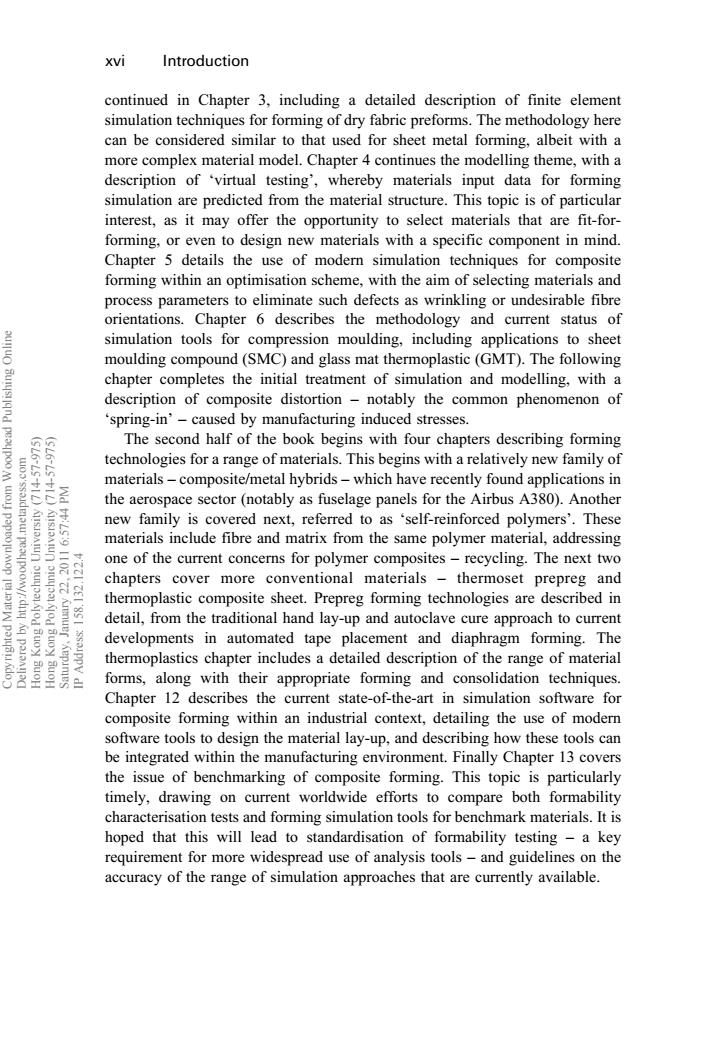正在加载图片...

XVI Introduction continued in Chapter 3,including a detailed description of finite element simulation techniques for forming of dry fabric preforms.The methodology here can be considered similar to that used for sheet metal forming,albeit with a more complex material model.Chapter 4 continues the modelling theme,with a description of 'virtual testing',whereby materials input data for forming simulation are predicted from the material structure.This topic is of particular interest,as it may offer the opportunity to select materials that are fit-for- forming,or even to design new materials with a specific component in mind. Chapter 5 details the use of modern simulation techniques for composite forming within an optimisation scheme,with the aim of selecting materials and process parameters to eliminate such defects as wrinkling or undesirable fibre orientations.Chapter 6 describes the methodology and current status of simulation tools for compression moulding,including applications to sheet moulding compound(SMC)and glass mat thermoplastic(GMT).The following chapter completes the initial treatment of simulation and modelling,with a description of composite distortion -notably the common phenomenon of spring-in'-caused by manufacturing induced stresses. The second half of the book begins with four chapters describing forming technologies for a range of materials.This begins with a relatively new family of materials-composite/metal hybrids-which have recently found applications in the aerospace sector(notably as fuselage panels for the Airbus A380).Another new family is covered next,referred to as self-reinforced polymers'.These materials include fibre and matrix from the same polymer material,addressing one of the current concerns for polymer composites-recycling.The next two chapters cover more conventional materials-thermoset prepreg and thermoplastic composite sheet.Prepreg forming technologies are described in detail,from the traditional hand lay-up and autoclave cure approach to current 00 developments in automated tape placement and diaphragm forming.The 、%y thermoplastics chapter includes a detailed description of the range of material forms,along with their appropriate forming and consolidation techniques. Chapter 12 describes the current state-of-the-art in simulation software for composite forming within an industrial context,detailing the use of modern software tools to design the material lay-up,and describing how these tools can be integrated within the manufacturing environment.Finally Chapter 13 covers the issue of benchmarking of composite forming.This topic is particularly timely,drawing on current worldwide efforts to compare both formability characterisation tests and forming simulation tools for benchmark materials.It is hoped that this will lead to standardisation of formability testing -a key requirement for more widespread use of analysis tools-and guidelines on the accuracy of the range of simulation approaches that are currently available.continued in Chapter 3, including a detailed description of finite element simulation techniques for forming of dry fabric preforms. The methodology here can be considered similar to that used for sheet metal forming, albeit with a more complex material model. Chapter 4 continues the modelling theme, with a description of `virtual testing', whereby materials input data for forming simulation are predicted from the material structure. This topic is of particular interest, as it may offer the opportunity to select materials that are fit-forforming, or even to design new materials with a specific component in mind. Chapter 5 details the use of modern simulation techniques for composite forming within an optimisation scheme, with the aim of selecting materials and process parameters to eliminate such defects as wrinkling or undesirable fibre orientations. Chapter 6 describes the methodology and current status of simulation tools for compression moulding, including applications to sheet moulding compound (SMC) and glass mat thermoplastic (GMT). The following chapter completes the initial treatment of simulation and modelling, with a description of composite distortion ± notably the common phenomenon of `spring-in' ± caused by manufacturing induced stresses. The second half of the book begins with four chapters describing forming technologies for a range of materials. This begins with a relatively new family of materials ± composite/metal hybrids ± which have recently found applications in the aerospace sector (notably as fuselage panels for the Airbus A380). Another new family is covered next, referred to as `self-reinforced polymers'. These materials include fibre and matrix from the same polymer material, addressing one of the current concerns for polymer composites ± recycling. The next two chapters cover more conventional materials ± thermoset prepreg and thermoplastic composite sheet. Prepreg forming technologies are described in detail, from the traditional hand lay-up and autoclave cure approach to current developments in automated tape placement and diaphragm forming. The thermoplastics chapter includes a detailed description of the range of material forms, along with their appropriate forming and consolidation techniques. Chapter 12 describes the current state-of-the-art in simulation software for composite forming within an industrial context, detailing the use of modern software tools to design the material lay-up, and describing how these tools can be integrated within the manufacturing environment. Finally Chapter 13 covers the issue of benchmarking of composite forming. This topic is particularly timely, drawing on current worldwide efforts to compare both formability characterisation tests and forming simulation tools for benchmark materials. It is hoped that this will lead to standardisation of formability testing ± a key requirement for more widespread use of analysis tools ± and guidelines on the accuracy of the range of simulation approaches that are currently available. xvi Introduction Copyrighted Material downloaded from Woodhead Publishing Online Delivered by http://woodhead.metapress.com Hong Kong Polytechnic University (714-57-975) Hong Kong Polytechnic University (714-57-975) Saturday, January 22, 2011 6:57:44 PM IP Address: 158.132.122.4